Lesser flamingos — which are also called African flamingos — live in some of the world’s most extreme aquatic environments. And if development around these lakes isn’t stopped, nearly 75% of the world’s wild population of lesser flamingos could be wiped out.

Lesser Flamingo
Phoeniconaias minor
Lesser Flamingo Scientific Classification
- Kingdom: Animalia
- Phylum: Chordata
- Class: Aves
- Order: Phoenicopteriformes
- Family: Phoenicopteridae
- Genus: Phoeniconaias
- Species: Phoeniconaias minor
Lesser Flamingo Appearance
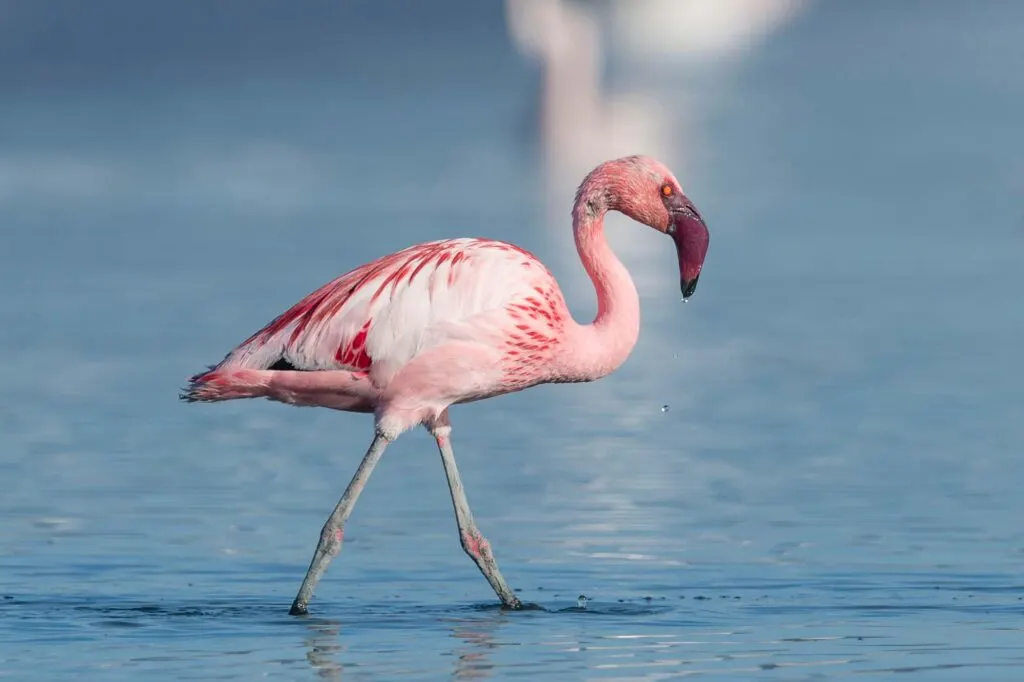
- Lifespan: x years
- Length: x inches
- Height: x inches
- Weight: x pounds
- Top speed: x mph
Lesser flamingos are the smallest and brightest of the four flamingo species (American, Chilean, and greater flamingo). Depending on age and sex, they can weigh between 2.6 to 6 pounds and stand between 31 and 35 inches tall.
Their wingspans vary from 35 to 41 inches. And although there are exceptions to the rule, females tend to be smaller than males. However, it’s nearly impossible to tell males from females just by looking at them.
Like all species of flamingo, lessers have red-pink plumage, white primary feathers, black secondary feathers, long necks, and small heads.
Lesser flamingos stand on webbed feet with a hallux — or hind toe — which distinguishes them from greater flamingos. Lesser flamingos also have shorter legs than greater flamingos.
Another way to differentiate between greater and lesser flamingos is the bill. The latter’s beak is dark red with a large black tip, while the former has pink beaks with small black tips.
Lesser flamingos have small orange-yellow eyes ringed with either purple or maroon bands. There’s one on either side of the head.
Did you know? The word flamingo comes from the Portuguese phrase for “red goose.”
Lesser Flamingo Range & Habitat
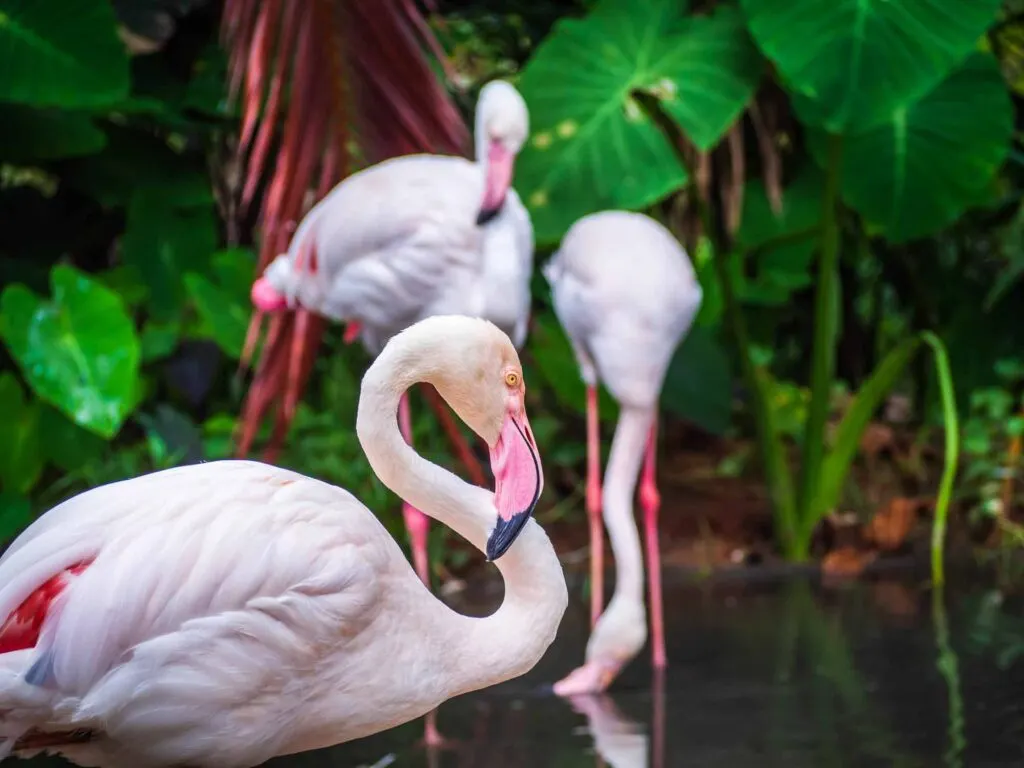
There are currently five lesser flamingo breeding populations in four range regions, mostly in sub-Saharan Africa, but also in Asia.
- Rift Valley lakes in eastern Africa, including Kenya, Ethiopia, and Tanzania
- West Africa, including Senegal and Mauritania
- Southern Africa, including Botswana, South Africa, and Namibia
- South Asia, including India and Pakistan
Lesser flamingos live in some of the world’s most extreme aquatic environments: hyper-saline lagoons and estuaries. Their main breeding grounds are:
- Etosha Pan: A salt pan in the Kalahari Basin in northern Namibia
- Makgadikgadi Pan: A salt pan in Botswana
- Kamfers Dam: A privately owned wetland in South Africa
- Lake Nakuru: One of the Rift Valley lakes in Kenya
- Zinzuwadia and Purabcheria: Salt pans in northwestern India
Distribution
- Continents: Africa, Asia.
- Countries: Angola, Afghanistan, Botswana, Burundi, Cameroon, Chad, Congo, Djibouti, Eritrea, Ethiopia, Eswatini, Egypt, Ghana, Gabon, Gambia, Guinea, Guinea-Bissau, India, Iran, Kenya, Lesotho, Madagascar, Malawi, Mauritania, Mozambique, Mauritius, Morocco, Niger, Nigeria, Oman, Pakistan, Rwanda, Senegal, Sierra Leone, Sudan, South Africa, Saudi Arabia, Somalia, Sao Tome and Principe, Sri Lanka, Spain, Réunion Island, Tanzania, Uganda, United Arab Emirates, Yemen, Zambia, Zimbabwe.
Habitats
Wetlands (inland) | Marine Neritic | Marine Intertidal | Marine Coastal/Supratidal | Artificial/Aquatic & Marine
Lesser Flamingo Behavior and Lifestyle
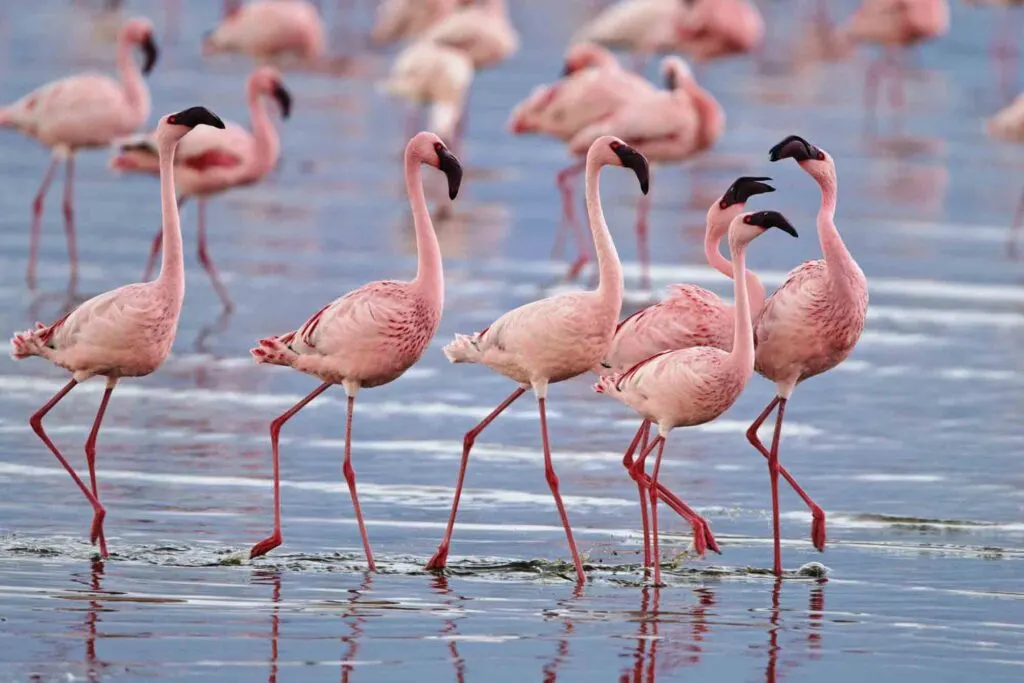
Watching flamingos is fascinating because of their unique behaviors.
The first thing people usually notice is that lesser flamingos — like all flamingos — like to stand on one leg.
Scientists aren’t 100% sure why the birds do this, but the most popular theory is that it conserves energy. Not only do they hang out on one leg, but that’s how lesser flamingos sleep!
While slumbering, they also crane their necks around and lay their heads on their bodies.
The pink avian species is primarily nocturnal, meaning they’re most active at night. Since they like to feed when the shallow waters are calm, it usually happens after the sun goes down.
They also prefer to fly at night to take advantage of nighttime drafts that help power them through the air.
Populations in southern Africa and Asia regularly move between inland and coastal locations. Occasionally, greater flamingos will mingle with lesser flamingos. However, scientists don’t believe the two species mate.
Lesser Flamingo Diet

Lesser flamingos have incredibly complex internal filter systems that allow the animals to survive in otherwise toxic environments.
However, the birds must contrast to activate their built-in “sieve systems” by turning them upside down to eat!
Lesser flamingos feast on blue-green algae, which only grows in alkaline lakes. They’re stuffed with photosynthetic pigments that give the birds their signature pink hue.
Lesser flamingos also eat spirulina, an aquatic bacteria, and rotifers, tiny marine invertebrates.
Lesser Flamingo Reproduction and Mating
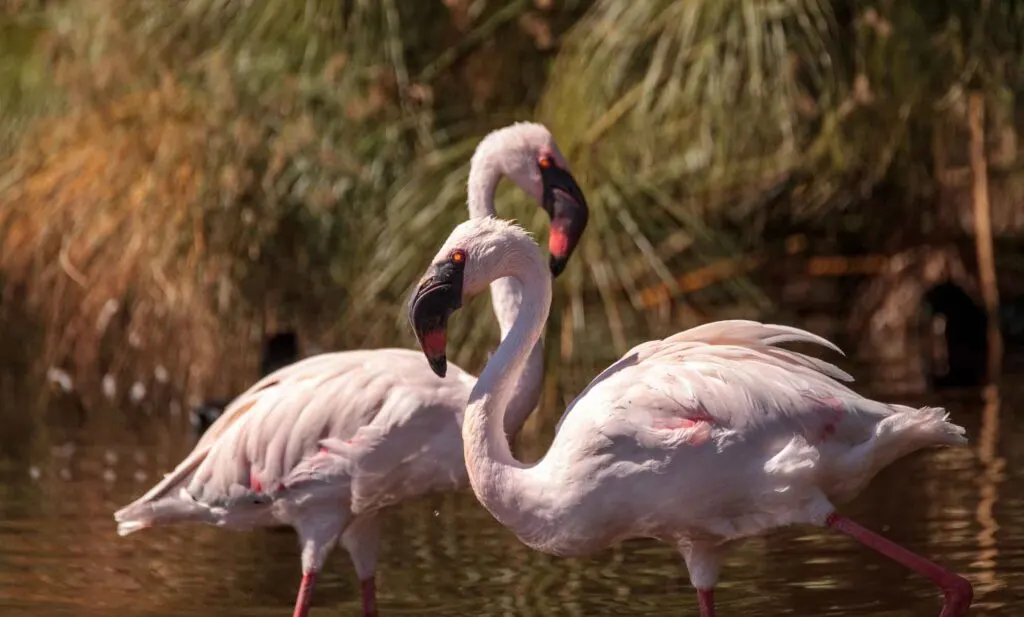
Lesser Flamingo Mating Season
Flamingos mate sometime between October and February, depending on their location.
The first event in the lesser flamingo’s mating season is torrential rains.
They flood breeding areas, making it impossible for terrestrial predators to reach them and their eggs. Moreover, the rain provides the necessary mud for their incubation mounds.
Lesser Flamingo Partnering and Incubation
The flamingo mating ritual is similar for all species of the bird. Essentially, the men try to impress the ladies, and matches typically last the whole season because the parents help incubate, rear, and feed the chick.
However, all lesser flamingo mating partnerships aren’t all pairs. Sometimes there are throuples and quads of varying sex configurations.
For example, you could have a collaboration of two females and one male, wherein both females lay an egg. Families with two males and one female also happen — as do partnerships of two males and two females.
Lesser flamingos do what can best be described as “a mating dance,” and brighter birds typically have more success finding a partner.
The adults incubate eggs for about 28 days, and the chicks are born with soft gray feathers. After a few weeks, they begin to turn brown.
Lesser Flamingo Chicks
Chicks join creches — which can be as large as 100,000 individuals — soon after hatching. Creches are like preschool for chicks.
They’re guided by a handful of adult flamingos who take the babies on their first trip to freshwater, which can be up to 20 miles away. Chicks also learn other lessons about being a flamingo in their creches.
Young fledglings stick around their parents for about 75 days. Both males and females provide crop milk to their offspring.
At around six years old, lesser flamingos reach reproductive maturity. In the wild, they can live up to 50 years. In captivity, lesser flamingos usually make it past 60.
Lesser Flamingo Conservation Status
Near threatened[1]
Lesser Flamingo Predators and Threats
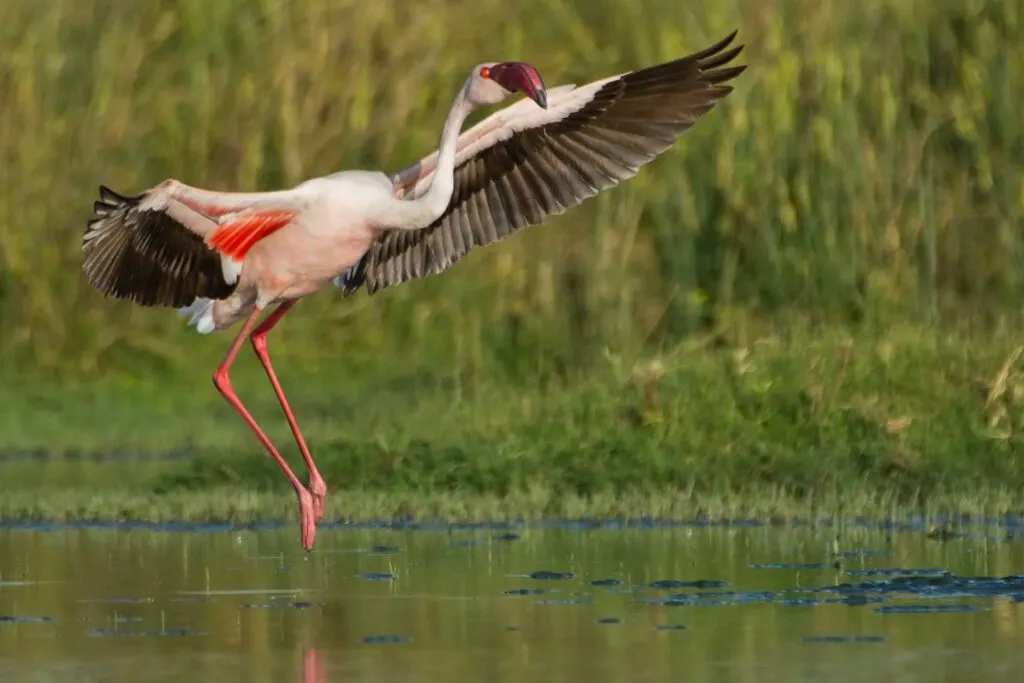
Lesser flamingos have several natural predators, including marabou storks, vultures, baboons, African fish eagles, jackals, hyenas, foxes, big cats, martial eagles, and great white pelicans.
The International Union for the Conservation of Nature lists lesser flamingos as a Near Threatened animal. However, they’re the most populous of any flamingo species. How does that work?
The lesser flamingo’s habitats are under significant threat. As such, they’re in more danger than other flamingo species. Currently, the main concerns are pollution and human encroachment.
- Nakuru and Bogoria Lakes: Both lakes in east Africa are negatively affected by heavy metal poisoning.
- Lake Natron: Big corporations are lobbying hard to put a soda ash plant on Tanzania’s Lake Natron, which could devastate the local ecosystem.
- Kamfers Dam: Kamfers is the only lesser flamingo breeding ground in South Africa. Pollution and human encroachment are making it less hospitable by the year.
Lesser flamingos’ survival is dependent on the health of the planet’s alkaline and saline lakes — and currently, things aren’t looking too hot in that department.
Dam water diversion, lake integrity, industrial pollution, human encroachment, and soda ash extraction are all imminent threats to the health of the world’s alkaline lakes.
Lesser Flamingo Facts
Here are some interesting facts about the African flamingo:
- The current global population of lesser flamingos is between 2.2 and 3.2 million.
- The lesser flamingo populations in western Africa are smaller than those in southern and eastern parts of the continent.
- Lesser flamingos have the largest flocks of any flamingo species. One breeding flock contains over one million individuals, and they all have babies within a day of each other.
- Lesser flamingos are obligate filter eaters with about 10,000 microscopic layers in their bills used to sift toxic elements from their food.
- Flamingos have been around for a long time! Researchers have found fossils dating back 10 million years to the Miocene epoch.
- If a proposed hydroelectric power plant is allowed on Lake Natron, brine shrimp will be introduced to the ecosystem to clear the water of algae, which is the lesser flamingo’s main food source. This one act has the power to knock out 50% of the population.
- Lesser flamingos need to feed in alkaline lakes, aka soda lakes, which have a pH value between 9 and 12 and contain a high percentage of carbonate salts. Alkaline lakes are considered the most extreme aquatic environment on Earth.
- The animal group name of lesser flamingos is “flamboyance.” “Flock” and “colony” are also used.
